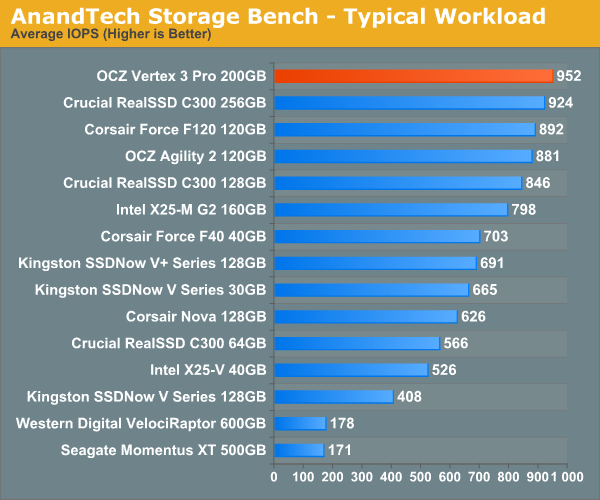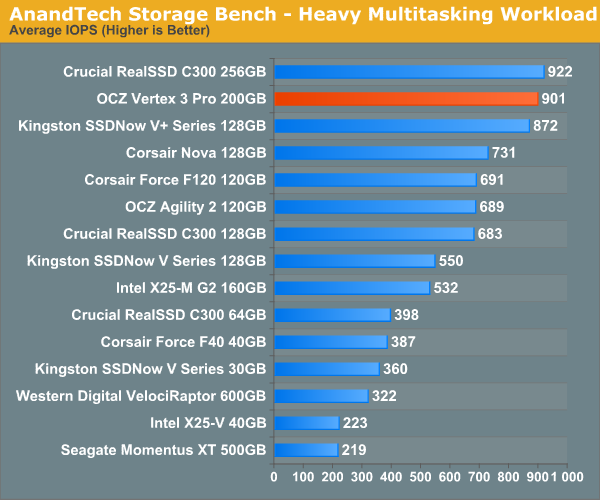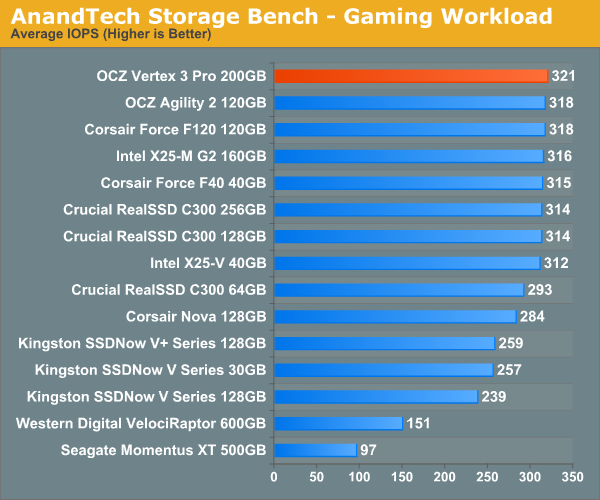OCZ Vertex 3 Pro Preview: The First SF-2500 SSD
by Anand Lal Shimpi on February 17, 2011 3:01 AM ESTAnandTech Storage Bench 2010
To keep things consistent we've also included our older Storage Bench. Note that the old storage test system doesn't have a SATA 6Gbps controller, so we only have one result for the Vertex 3 Pro (and the C300). The SF-2500 controller does respectably here, but with a 3Gbps controller we're only marginally faster than other SSDs (which is why we've moved to a new storage platform for 2011).
The first in our benchmark suite is a light/typical usage case. The Windows 7 system is loaded with Firefox, Office 2007 and Adobe Reader among other applications. With Firefox we browse web pages like Facebook, AnandTech, Digg and other sites. Outlook is also running and we use it to check emails, create and send a message with a PDF attachment. Adobe Reader is used to view some PDFs. Excel 2007 is used to create a spreadsheet, graphs and save the document. The same goes for Word 2007. We open and step through a presentation in PowerPoint 2007 received as an email attachment before saving it to the desktop. Finally we watch a bit of a Firefly episode in Windows Media Player 11.
There’s some level of multitasking going on here but it’s not unreasonable by any means. Generally the application tasks proceed linearly, with the exception of things like web browsing which may happen in between one of the other tasks.
The recording is played back on all of our drives here today. Remember that we’re isolating disk performance, all we’re doing is playing back every single disk access that happened in that ~5 minute period of usage. The light workload is composed of 37,501 reads and 20,268 writes. Over 30% of the IOs are 4KB, 11% are 16KB, 22% are 32KB and approximately 13% are 64KB in size. Less than 30% of the operations are absolutely sequential in nature. Average queue depth is 6.09 IOs.
The performance results are reported in average I/O Operations per Second (IOPS):

If there’s a light usage case there’s bound to be a heavy one. In this test we have Microsoft Security Essentials running in the background with real time virus scanning enabled. We also perform a quick scan in the middle of the test. Firefox, Outlook, Excel, Word and Powerpoint are all used the same as they were in the light test. We add Photoshop CS4 to the mix, opening a bunch of 12MP images, editing them, then saving them as highly compressed JPGs for web publishing. Windows 7’s picture viewer is used to view a bunch of pictures on the hard drive. We use 7-zip to create and extract .7z archives. Downloading is also prominently featured in our heavy test; we download large files from the Internet during portions of the benchmark, as well as use uTorrent to grab a couple of torrents. Some of the applications in use are installed during the benchmark, Windows updates are also installed. Towards the end of the test we launch World of Warcraft, play for a few minutes, then delete the folder. This test also takes into account all of the disk accesses that happen while the OS is booting.
The benchmark is 22 minutes long and it consists of 128,895 read operations and 72,411 write operations. Roughly 44% of all IOs were sequential. Approximately 30% of all accesses were 4KB in size, 12% were 16KB in size, 14% were 32KB and 20% were 64KB. Average queue depth was 3.59.

The gaming workload is made up of 75,206 read operations and only 4,592 write operations. Only 20% of the accesses are 4KB in size, nearly 40% are 64KB and 20% are 32KB. A whopping 69% of the IOs are sequential, meaning this is predominantly a sequential read benchmark. The average queue depth is 7.76 IOs.











144 Comments
View All Comments
semo - Saturday, February 19, 2011 - link
Thanks for looking in to the issue Anand. Could you also find out whether Revo drives are affected as well?I'm surprised that Anandtech did not make any mention of the 25nm drives (it could have warned a lot of people of the shortcomings)
erson - Thursday, February 17, 2011 - link
Anand, on page 3 - "In this case 4GB of the 256GB of NAND is reserved for data parity and the remaining 62GB is used for block replacement (either cleaning or bad block replacement)."I believe that should be 52GB instead of 62GB.
Keep up the good work!
Anand Lal Shimpi - Thursday, February 17, 2011 - link
So there's technically only 186GiB out of 256GiB of NAND available for user consumption. 4GiB is used for RAISE, the remaining 66GiB (the 62GiB is a typo) is kept as spare area.Take care,
Anand
marraco - Thursday, February 17, 2011 - link
Some data are written once, and never deleted. They are read again and again all the time.Such cells would last much longer than the rest.
I wish to know if the controller is smart enough to move that rarely written data to the most used cells. That would enlarge the life of those cells, and release the less used cells, whose life will last longer.
Chloiber - Thursday, February 17, 2011 - link
I'm pretty sure every modern Controller does that to a certain degree. It's called static and dynamic wear leveling.philosofa - Thursday, February 17, 2011 - link
Anand, you said that prices for the consumer Vertex 3 drives will probably be above those of the Vertex 2 series - is that a resultant increase in capacity, or will we see no (near term) price/size benefits from the move to 25nm nand?vhx - Thursday, February 17, 2011 - link
I am curious as to why there is no Vertex/2 comparison?jonup - Thursday, February 17, 2011 - link
Given the controversy with the currently shipped Vertex2s Anand chose to use F120 (similar if not identical to the Vertex2) .theagentsmith - Thursday, February 17, 2011 - link
Hello Anandgreat article as always and hope you're enjoying the nice city of Barcelona.
I've read some articles suggesting to create a RAM disk, easily done with PCs with 6-8GBs, and move all the temporary folders, as well as page file and browser caches to that.
They say this could bring better performance as well as reduce random data written to the SSD, albeit the last one isn't such a big problem as you said in the article.
Can you become a mythbuster and tell us if there are tangible improvements or if it just doesn't worth it? Can it make the system unstable?
Quindor - Thursday, February 17, 2011 - link
Maybe you missed this in the article, but as stated, with heavy usage of 7GB writing per day, it still will last you way beyond the warranty period of the drive. As such, maybe your temp files and browser cache, etc. to a ram drive won't really bring you much, because your drive is not going to die of it anyway.Better performance might be a different point. But the reason to buy an SSD is for great performance. Why then try to enhance this with a ram drive, that will only bring marginal performance gains. Doing so with a HDD might be a whole different thing together.
My idea is that these temp files are temp files, and that if keeping them in memory would be so much faster, the applications would do this themselves. Also, leaving more memory free might give windows disk caching the chance to do exactly the same as your ram drive is doing for you.